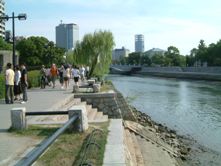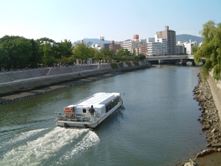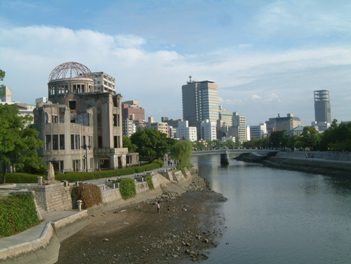
The Asian River Restoration Network was established in Nov. 2006 to support the exchange of information relating to environmental restoration of rivers and watersheds. JRRN has a role of ARRN secretariat currently.
Go to ARRN website

< World's WATERFRONT:JAPAN Category: Chugoku >
|
Photo by Yumi Imanishi, Sep.. 2007
|
For Ota River flowing though Hiroshima City, the national, prefectural, and city governments together developed a framework called “A Lagoon City of Hiroshima” in January 2003 to take progressive approaches toward the regeneration of a lagoon city in the green river area expanded in the postwar period. In this framework, three pillars of “to use,” “to create,” and “to connect” are provided to take the lead in social experiments in waterfront utilization and conduct waterfront restoration activities with the collaboration of citizens, companies, and government.
By JRRN-secre | Category: Community and urban river restoration,Chugoku | Comment(0) | Trackback(0) |
Date: 2012.01.05 16:17
Aiba River is a 2.6km-long, 4m-wide small river, flowing east and west in the old samurai residential area in Hiyako, Emukai and Kawashima districts with the reminiscent atmosphere of a castle town. In the past there were indigo-dye shops operated by the clan on the riversides and the water was deep blue all over the river, thus this river was called Aiba (indigo-dye shop) River.
This river was used originally for supplying water for agriculture and daily living. In the middle of the Edo Period, the river was excavated so that ships could pass to transport firewood and coal.
Today, the water is still used for irrigation, disaster-prevention and daily living and the landscape and environment is conserved under a public-private partnership. As a canal, it is indispensable for civil life as a tourist spot of Hagi City, a castle town. It was designated as one of the best 100 canals in Japan and it won the "Handmade Hometown Award2 in 1988.
By JRRN-secre | Category: Community and urban river restoration,History and traditional restoration,Chugoku | Comment(0) | Trackback(0) |
Date: 2011.09.10 18:38
Tsuwano Town called "a small Kyoto of Sanin" is famous for its beautiful streets and the carps living in Tsuwano River running through the center of the town. It has been famous as a district that produces high-quality water since olden days and sake breweries using the spring water stand in a row in the town.
In landscaping the town, iris-planted waterways were laid in many places and many houses keep carps by using the water. Just as in olden days, residents pump water from the waterway for domestic use even today.
Tsuwano waterways were awarded the "Civil Engineering Design Prize 2002, JSCE (Japan Society of Civil Engineers)" and a City Landscape Award in 2006.
By JRRN-secre | Category: History and traditional restoration,Chugoku | Comment(0) | Trackback(0) |
Date: 2011.09.10 18:34
Shinji Lake is located in the eastern area of Shimane Prefecture. It is a typical brackish lake in Japan together with Nakaumi. Its rich nature and excellent landscape are used for fishery, sightseeing and recreation.
However, the conditions surrounding the water environment are severe due to socioeconomic activities and the changes in lifestyle in the peripheral basin, thus water quality conservation is an important issue to be solved.
Under the circumstances, a “lake water quality conservation plan” to conserve the water quality has been drawn up and various water quality improvement programs are being conducted. In addition, activities to plant and grow reeds have been promoted by industry - government - academia - private collaboration including local elementary school students and the pollution load in the basin is steadily decreasing.
By JRRN-secre | Category: Bay and lake restoration,Chugoku | Comment(0) | Trackback(0) |
Date: 2011.09.10 18:11
Nishikawa Channel and its tributary Edagawa Channel take the water from Asahi River as the Asahi River joint canal, running southward through the center of Okayama City. They provide irrigation water for the paddy field spread in the south of the city. On either side of these canals, a water amenity park containing walkways, summerhouses, corridors over the waterway, etc. was constructed. It is popular among citizens as an esplanade.
In the Nishikawaryokudo, people enjoy the firefly canal created by dividing the water, a wind-up doll using a waterwheel, a cascade and a terrace over the water. In the Edagawaryokudo, a calm space is provided, where stones produced in Okayama Prefecture are positioned in a Japanese garden style.
Nishikawa Canal was designated as one of the best 100 canals in Japan.
By JRRN-secre | Category: History and traditional restoration,Chugoku | Comment(0) | Trackback(0) |
Date: 2010.09.10 18:36
In the mouth of Fushino River running through Yamaguchi City, a vast tidal flat spreads, which is one of the greatest tidal flats in the West Setouchi region. It attracts migrant birds and it was selected as one of the 500 important wetlands in Japan.
However, due to the floating mud flowing in from the middle and upstream basins and the delay in taking domestic sewage countermeasures, oystershells were built up, the muddy tidal flat area was expanded and the biomass of fish, crabs and wild birds was decreased. To address this problem of the tidal flat ecosystem alteration a “framework to create a rich basin of Yamaguchi (Fushino River model)” was drawn up through collaboration between industry, educational institutions and the administration in March 2003. Today, the organizations concerned are cooperating to regenerate the tidal flats and create Zostera beds on a trial basis and wild bird research and beach cleaning is being performed.
By JRRN-secre | Category: Nature oriented restoration,Bay and lake restoration,Chugoku | Comment(0) | Trackback(0) |
Date: 2010.09.10 18:12








